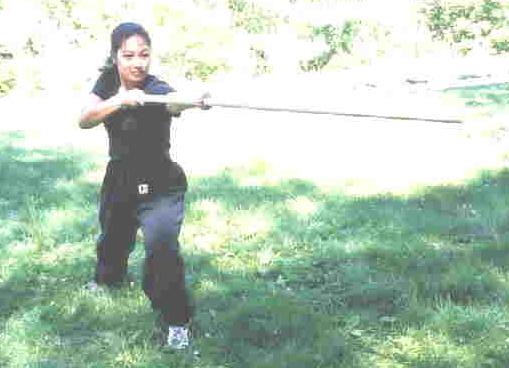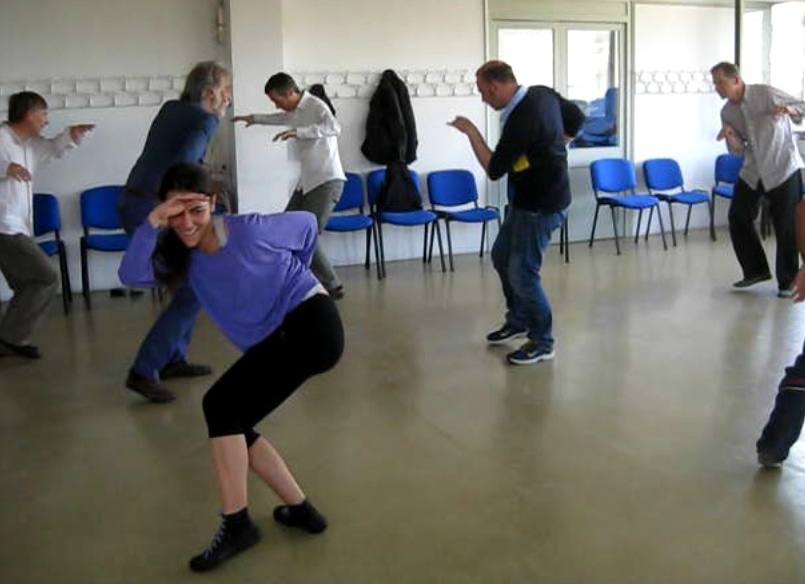SELECTION OF QUESTIONS AND ANSWERS
MAY 2016 PART 2

Shaolin kungfu is different from Shaolin wushu
Question 1
One of my students told me that due to his very good practice he had a very strong sex drive. He asked me whether there was any exercise or skill to get more control over his sex drive.
Can you please give some advice on how to get control over excessive sex drive?
What have the Shaolin monks done to control their natural, sexual desire?
— Sifu Leonard Lackinger, Austria
Answer
A good way for your student to expend the energy derived from his training is set practice or sequence practice. He can also spend more time outdoors with his friends or parents.
Those who know the Small Universe, it is an excellent way to control sexual desires, besides giving practitioners many benefits.
I don't know about the sexual desires of modern Shaolin monks. But I know as a fact that one famous modern Shaolin monk, who is often regarded as an authority in the West on Shaolin wushu, though many people due to their lack of understanding call it Shaolin Kungfu which is actually different, openly has a wife, who is his student, and a daughter.
It was not stated but it could be reasonably concluded that his sexual desire was so strong, and obviously out of his control, that he blatantly broke a prominent law for Mahayana monks that forbid marriage. But his students, at least some of them, considered him a Buddha, and remarked that he was above laws, forgetting that even the Buddha himself followed the laws he set.
It should be noted that there is nothing in Buddhism against having wholesome sex. The Buddha himself encouraged a happy family life, which obviously included sex. But Mahayana monks are different. They had voluntarily renounced worldly life, including having sex, to attain Enlightenment. The law forbidding them to have sex is to help them as sexual desire is very powerful in abiding them to the phenomenal world.
From records Shaolin monks in the past did not have problems controlling their sexual desire. They did a lot of set practice and sequence practice. Advanced monks performed the Small Universe.
An important reason why sexual desires were not a problem with Shaolin monks in the past was that they were real monks who dedicated themselves to spiritual cultivation. They realized it was a rare privilege to be monks at the Shaolin Monastery. The modern Shaolin monks, according to a story, were not real Shaolin monks. They were expert wushu practitioners recruited by a German entrepreneur, put on a monk's robe and had their head shaven, to tour the West to present Shaolin wushu. Many of them stayed back in the West to teach wushu.
Question 2
I have been practicing the Flowing Water Staff since we last met. What is the ideal size and shape of the staff?
Answer
The Flowing Water Staff was the legacy of my sifu, Sifu Ho Fatt Nam. He remained undefeated in combat, including weapon combat, though he was challenged by many masters. He had a draw with an Indian master who used a strange weapon that was like ribbon knives.
A master can pick up any material and use it effectively as a weapon. So, for us the concept of a weapon with ideal size, shape and length becomes irrelevant.

Sifu Emiko Hsuen performing the Flowing Water Staff
Question 3
In the Flowing Water Staff Set shown at https://www.shaolin.org/review/flowing-water-staff.html, is there a more sophisticated application to the first pattern "Open Mountain Chop Rock" (Pattern 2) than hitting someone who is already on the ground?
Answer
"Open Mountain Chop Rock" is a useful method to train staff-force. When you are successful in your training, you can test your staff-force by breaking a brick supported on two bricks with your staff using the pattern "Open Mountain Chop Rock", like when you break a brick with your palm. Later you can just place a brick flat on the ground and break it with the staff.
When you have the staff-force, you can strike an opponent's head or any part of his body with any suitable pattern, not necessarily using "Open Mountain Chop Rock".
In the hands of a master, any simple pattern can become sophisticated. When an opponent attacks you in any way with any weapon, step aside and break his skull with "Open Mountain Chop Rock". But as Shaolin disciples, we are merciful. So instead of striking his head, we can just strike his hands.
Question 4
Is there an application to "Treasure on Ground" (Pattern 49) or is it only a transitional pattern?
Answer
"Treasure on Ground" is not just a transitional pattern. You can strike an opponent's foot. Or you can strike an opponent's hand holding a weapon and let your staff go all the way to the ground.
Editorial Note: Sifu Leanard's other questions will be continued in the following issue, May 2016 Part 3.

Taijiquan is an internal martial art
Question 5
Can you please tell us what is qi and what is shen?
— Miguel, Spain
Answer
In the first book I wrote (but the second to be published), "Introduction to Shaolin Kungfu", I translated qi as intrinsic energy. I believe I was the first person to use the term "intrinsic energy" to mean qi. I was quite happy that this term caught on, and a few people used intrinsic energy to describe qi.
Later, like in "The Art of Chi Kung" and "The Complete Book of Chinese Medicine", I translated qi as vital energy when found in persons, and as cosmic energy when found outside persons. Now I just use energy to mean qi.
Shen has not presented any problems. All the while I have understood and translated shen as spirit, soul, mind or consciousness, depending on the culture of the people using the terms. All these translations refer to the same concept -- the non-physical, real being -- though the connotations for some people may be different. A religious person referring to shen as soul will have quite different connotations to a scientist referring to shen as consciousness.
I was also aware that many spiritualists of the Indian tradition differentiated between mind and soul, and that Buddhists of the Theravada tradition did not believe in the soul. Many Westerners also shared the concepts of these two traditions. But in the Shaolin tradition, which follows the Mahayana Buddhist tradition, the soul and the mind are the same, and are referred to in classical Chinese as "xin", which is uaually translated as "heart".
In my writing on Buddhist philosophy, I have suggested that Buddhists believe in the soul, though some Buddhists, like Theravadins, call it the mind. The Buddha, for example, clearly stated that since the time he vowed to save the world when he and his mother were drown, had gone through 500 reincarnations to be finally reborn as Siddhatha Guatama and attained Enlightenment, and it was his same soul that had been reincarnated in different bodies.
Question 6
What do you mean by saying that Taijiquan is an internal martial art?
— Juan, Spain.
Answer
There are three factors in the statement that Taijiquan is an internal, martial art -- namely internal, martial and art.
Taijiquan is internal. This means that its effectiveness and benefits are due to internal force, not muscular strength. As internal force is not dependent on size, age and gender, a tiny woman of sixty can effectively fell a young, muscular man of thirty. The tiny elderly woman has the benefits of good health and vitality besides longevity, whereas the young muscular man may be sick and tired.
Taijiquan is martial. This means that the tiny, elderly woman can use her art for combat. If a Karate or a Taekwondo black-belt, for example, were to attack her, despite the attacker's size and strength, the woman can effectively handle the attacker.
Taijiquan is an art. To be skilful as well as to derive benefits from the art, a Taijiquan practitioner has to practice and practice what he has learned. If he just learns and learns but does not practice, he may not be skilful and may not enjoy its benefits.
If any one of these three factors is missing, then it is not Taijiquan. If practitioners practice merely Taijiquan techniques but have no internal force, their art is not Taijiquan.
If practitioners cannot apply what they practice for combat, it is not Taijiquan.
If practitioner is knowledgeable about the subject but does not practice it as an art, then it is not Taijiquan.

The Monkey Play of Five-Animal Play
Question 7
Would it be an acceptable form of healing the body for someone to visualize their injured or diseased body part and then attempt to direct the body to remove a particle that makes up the injured part or cells and replace it with a fresh, new particle that might help the healing process.
— Aaron, UK
Answer
I would not recommend you to try what you described to heal an illness or injury. There are three good reasons.
1. What you described is conjecture. Whether it is what you think, is debatable. It is not worth risking the attempt, especially when we have more than efficient ways to overcome illness or injury.
2. Even if what you think is true, the person attempting it may not have the skill to do so correctly. Doing a technique correctly but using a wrong skill may bring a lot of harm.
3. This is the most important reason. We have established methods to overcome illness or injury, proved effective over thousands of years. Just practice the chi kung the way you have been taught, and you will have good results. Even if you can attain only 30% proficiency, it is more than sufficient to overcome illness or injury.
In other words, our chi kung is so powerful that you don't have to attempt getting the best result. If you can have just mediocre result, about 30% efficiency, you will not only be able to overcome illness and injury but also have good health, vitality and longevity. Indeed, if a practitioner attempts to get the best result from his practice, he may over-train.
Question 8
I do need to clarify that I have not and still probably will not try it, as physics is not my area of expertise, but I felt like I should ask about it seeing as you do reference the ability to manipulate molecular structures with ones chi which can help in healing. Also, please do not worry about me being a slave to intellectualizing as I do set aside my thoughts during my practice and meditation so that my mind can be free of as many distracting thoughts, worries, and interference as I possibly can.
Answer
I am glad that you don't intellectualize while practicing our chi kung. Just follow the three golden rules when practicing, namely don't worry, don't intellectualize and enjoy your practice. You will have wonderful results for your effort.
LINKS
Selected Reading
- Abstinence from Sex?
- Grasping Sparrow's Tail: Mechanics of Taijiquan Movements
- Non-Thought Manifested in Shaolin Kungfu
- Free Sparring in Shaooin Wahnam More than 20 Years Ago
- Fifth Brother Octagonal Staff
